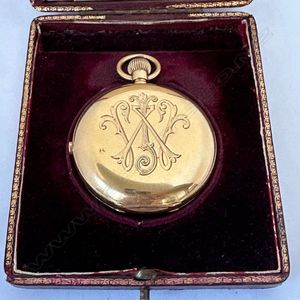18ct Gold Hunter Chronograph Pocket Watch by J.W. Benson
18ct gold hunter chronograph pocket watch by J.W. Benson, number 266755 51 mm plain case stamped with Swiss bureaux de controle - three heads of Helvetia, (from 1887), the higher standard of 0.755' for 18ct gold watch cases exported to the UK. The hinged covers and inner dust cover all with matched numbers to the movement. The cover engraved with monogram WJ. keyless, 3/4 plate movement signed: 'Swiss Made. Exd. By J. W. Benson, 62 & 64 Ludgate Hill, London. By Warrant to H. M. The Late Queen Victoria. 266755'. 110gm White enamel dial, Roman numerals, minute and seconds indices, Arabic numeral five minute division; sunken subsidiary seconds dial at IX, subs elapsed 60 minutes dial at III, blued steel centre seconds with actuating pusher at XII. Gold hands. In original red Morocco box with red velvet lining. Inside the lid printed in gilt with the watchmaker's address beneath the Royal Warrant Coat of Arms.
You must be a subscriber, and be logged in to view price and dealer details.
Subscribe Now to view actual auction price for this item
When you subscribe, you have the option of setting the currency in which to display prices to $Au, $US, $NZ or Stg.
This item has been sold, and the description, image and price are for reference purposes only.
- Chronograph - A chronograph is a watch that also incorporates the features of a stopwatch, to measure elapsed time. Most chronographs are operated by two buttons, one to start and stop the chronograph second hand, and the other to return that hand to the starting position.
- Hunter - A hunter pocket watch is the type where the case includes a spring-hinged circular metal lid or cover, that closes over the glass face of the watch, protecting it from dust, scratches and other damage or debris. The majority of antique and vintage hunter-case watches have the lid-hinges at the 9 o?clock position, suiting the right handed user.
- Keyless Watch - A keyless watch is a type of pocket watch or wristwatch that does not require a separate winding key to wind or set the time. Instead, a keyless watch is wound and set by a small knob or button located on the side of the watch, called a crown.
Keyless watches were first introduced in the late 19th century and quickly became popular due to their convenience and ease of use. Prior to the development of keyless watches, pocket watches were typically wound and set using a small key that was inserted into a hole in the watch case. The key would be turned to wind the watch's mainspring, and then turned again to set the time.
With the introduction of the keyless watch, watchmakers were able to simplify the winding and setting process by eliminating the need for a separate key. Instead, the crown on the side of the watch could be pulled out to set the time, and then pushed back in to wind the watch's mainspring.
The keyless watch design has since become the standard for most modern watches, both pocket and wristwatches. In addition to being more convenient to use, keyless watches are also typically more reliable and accurate than earlier models that used winding keys. - Movement - The technical name for the workings of a clock or watch, and does not include the dial or case.
This item has been included into following indexes:
- Benson, J. W. (England)
- chronographs 690
- pocket watches, case type - hunter, gold cased 387
- pocket watches, country - Swiss made 463
